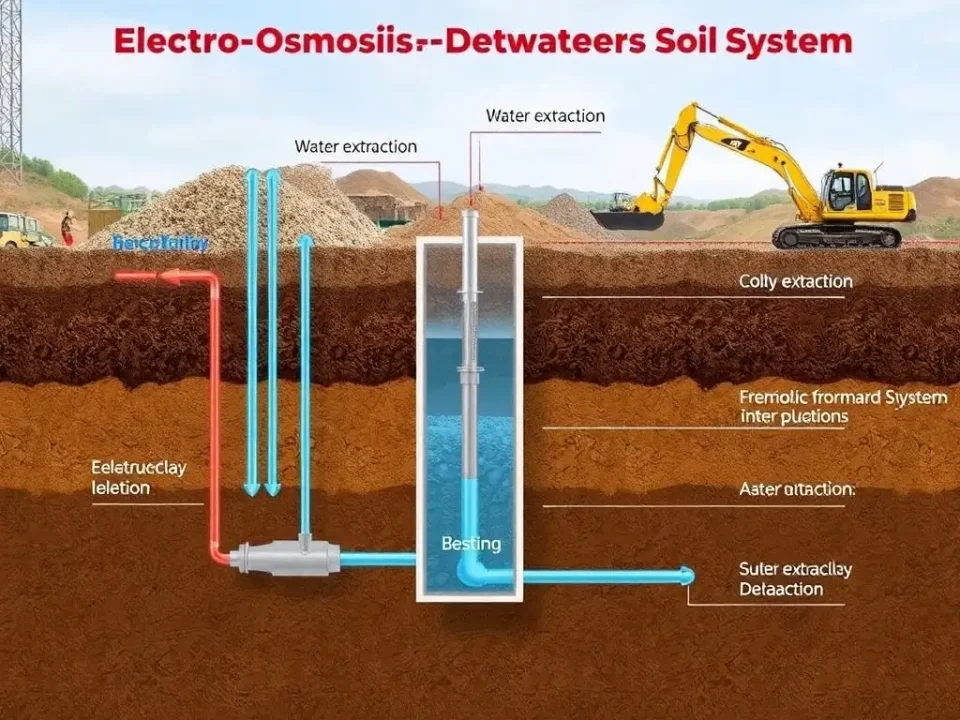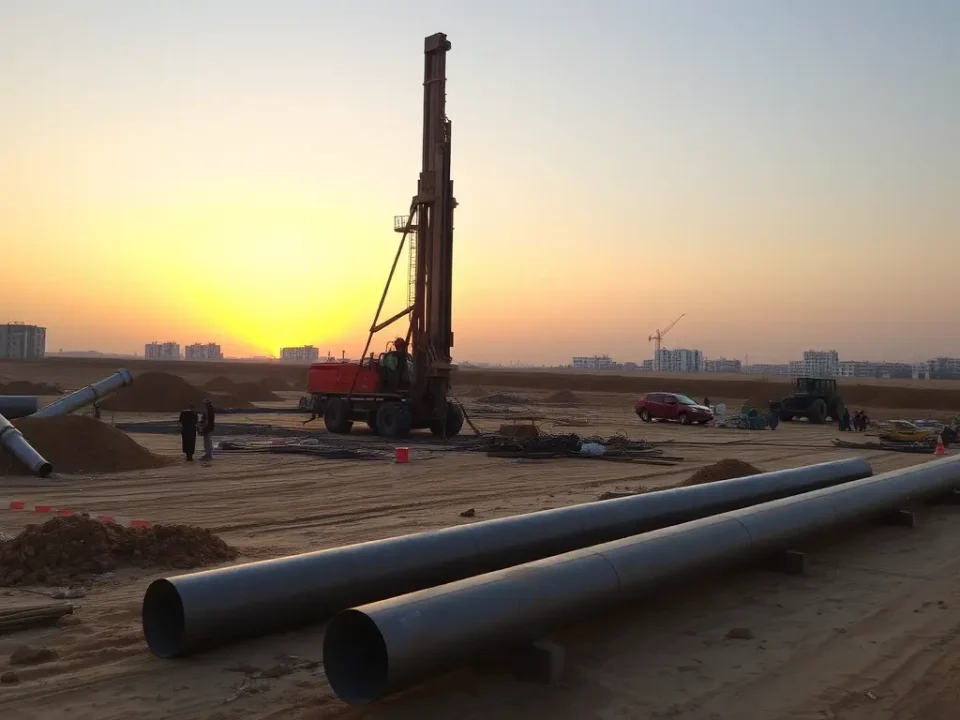
7 Key Benefits of Mini Piles Construction
March 18, 2025
Understanding Dewatering System Types and Costs
April 29, 2025Pile foundations are crucial for residential construction, especially in areas with unstable soil conditions. They provide deep support, transferring the structure’s load to more stable layers beneath the surface. By utilizing a pile foundation for house, builders can ensure enhanced stability, reduce the risk of settlement, and prolong the lifespan of the structure. This method is particularly beneficial in regions prone to flooding or where traditional foundations may fail.
What Are Pile Foundations for House?
Pile foundations for house are deep foundation systems designed to support structures by transferring loads to deeper, more stable soil layers. Unlike traditional shallow foundations, which rest on the surface, pile foundations extend down through weak or unstable soil to reach stronger ground. Made from materials like concrete, steel, or timber, these piles are driven or drilled into the earth, providing the necessary support for various types of residential buildings. The use of a pile foundation for houses is particularly advantageous in areas with poor soil conditions, ensuring the structure remains stable and secure over time.
Different Types of pile foundation for house
There are several types of pile foundation for house, each designed to meet specific structural and soil conditions:
- End-Bearing Piles: These piles transfer the load of the structure directly to a strong soil layer or rock beneath the surface. They are effective in areas with a solid base, ensuring maximum stability.
- Friction Piles: In contrast to end-bearing piles, friction piles rely on the friction between the pile surface and the surrounding soil to support the structure. They are ideal for softer soils where end-bearing is not feasible.
- Composite Piles: These consist of multiple materials, often combining concrete and steel. Composite piles are used to optimize strength and resistance in various soil conditions, making them versatile for different house types.
- Drilled Shaft Piles: Also known as caissons, these piles are excavated and then filled with concrete. They are suitable for deep foundations and provide excellent load-bearing capacity.
- Micropiles: These are small-diameter piles that can be installed in limited access areas. They are often used for retrofitting existing structures or in challenging soil conditions.
Using the appropriate type of pile foundation for houses ensures that the structure is well-supported, minimizing risks associated with soil instability.
Advantages of Pile Foundations for Houses
Pile foundations for houses offer numerous benefits, making them a preferred choice in various construction scenarios:
- Enhanced Stability: By reaching deeper into the ground, pile foundations provide a stable base that can withstand heavy loads, reducing the risk of settlement.
- Suitable for Poor Soil Conditions: In areas with weak or unstable soils, a pile foundation for houses is essential. It ensures that the structure is supported on more solid ground, preventing potential structural issues.
- Resistance to Uplift Forces: Pile foundations effectively resist uplift forces caused by wind or seismic activity, making them ideal for houses in regions prone to such conditions.
- Reduced Construction Time: Pile installation can often be completed more quickly than traditional foundations, speeding up the overall construction process.
- Minimized Excavation Requirements: Pile foundations typically require less excavation than shallow foundations, leading to reduced disruption of the surrounding environment.
- Adaptability: They can be used for various types of buildings and terrains, providing flexibility in design and construction.
Overall, the advantages of using a pile foundation for houses contribute significantly to the durability and safety of residential structures.
Materials Used in Pile Foundations for Houses
The choice of materials for pile foundations for houses is crucial, as they must provide strength, durability, and resistance to environmental factors. Common materials include:
- Concrete: This is the most widely used material for pile foundations. Concrete piles can be precast or cast-in-situ, offering high compressive strength and durability against weathering and corrosion.
- Steel: Steel piles are known for their high strength-to-weight ratio and resistance to deformation. They are often used in environments where heavy loads or seismic activity are a concern.
- Timber: While less common today, timber piles can still be used in certain applications, especially in residential construction. Treated wood piles are resistant to rot and insects, making them suitable for specific soil conditions.
- Composite Materials: These combine different materials, such as concrete and steel, to optimize strength and performance. Composite piles can be tailored to meet specific load requirements and environmental conditions.
- Fiber-Reinforced Polymer (FRP): An emerging option, FRP piles are lightweight and resistant to corrosion, making them ideal for marine or other harsh environments.
Selecting the appropriate materials for a pile foundation for houses ensures the longevity and safety of the structure, adapting to various soil conditions and loading scenarios.
Installation of Pile Foundations for Houses
The installation of pile foundations for houses involves a series of systematic steps to ensure proper support and stability. Here’s an overview of the typical installation process:
- Site Assessment: Before installation, a thorough site assessment is conducted to evaluate soil conditions, load requirements, and environmental factors. This helps determine the type and depth of piles needed.
- Design Planning: Based on the assessment, engineers design the pile foundation system, specifying the type of piles (e.g., end-bearing, friction) and their arrangement to support the house effectively.
- Drilling or Driving: Depending on the type of pile foundation for houses, the next step involves either drilling holes for drilled shaft piles or driving pre-formed piles into the ground using a pile driver. This process requires precision to ensure proper alignment and depth.
- Placement of Reinforcement: For concrete piles, reinforcement bars (rebar) are placed within the piles to enhance strength. This step is crucial for ensuring the piles can withstand the load of the house.
- Concrete Pouring: If using cast-in-situ concrete piles, concrete is poured into the drilled holes. For precast piles, they are positioned and secured in place.
- Curing: After pouring, concrete piles must cure to achieve their full strength. This process can take several days, depending on the weather and materials used.
- Load Testing: Once the piles are installed, load testing may be performed to ensure they can support the intended loads without excessive settlement.
- Finalizing the Foundation: After successful testing, the pile foundation for the house is connected to the superstructure, completing the installation process.
Proper installation of pile foundations is critical to the overall integrity and safety of the house, ensuring it remains stable and durable for years to come.
Factors Affecting the Selection of Pile Foundations in Construction
Selecting the appropriate pile foundation for house involves considering various factors that can influence its effectiveness and suitability. Key factors include:
- Soil Conditions: The type and characteristics of the soil, such as its bearing capacity, density, and moisture content, play a crucial role in determining the type of pile foundation required. Soil tests help identify whether end-bearing or friction piles are more appropriate.
- Load Requirements: The weight and load distribution of the structure must be analyzed. Different pile types can support varying load capacities, so understanding the specific demands of the house is essential for selection.
- Environmental Conditions: Factors such as groundwater levels, seismic activity, and potential for soil erosion or settlement influence the choice of pile materials and design. Pile foundations must be resilient to local environmental challenges.
- Construction Methods: The available construction techniques and equipment can impact the choice of pile foundation. For instance, some methods may be more suitable for urban areas with limited access.
- Cost Considerations: Budget constraints often influence material and design choices. While certain pile foundations may offer superior performance, their costs must be justified against the project’s financial limits.
- Regulatory Requirements: Local building codes and regulations may dictate specific requirements for foundation design and materials. Compliance with these regulations is essential in the selection process.
- Future Expansion: If there are plans for future expansion or additional loads, selecting a pile foundation that can accommodate these changes is important for long-term usability.
By considering these factors, builders can make informed decisions about the most suitable pile foundation for house, ensuring stability, safety, and cost-effectiveness in construction.
Why Soil Testing Is a Must Before You Build
Soil testing is a critical step in the construction process, particularly when planning for a pile foundation for houses. Here are several reasons why it is essential:
- Determining Soil Properties: Soil tests reveal key characteristics such as bearing capacity, density, moisture content, and composition. Understanding these properties helps engineers select the appropriate foundation type and design.
- Identifying Soil Stability: Testing helps assess the stability of the soil, identifying issues like settlement or liquefaction that could affect the structure. This knowledge allows for proactive measures to ensure safety.
- Preventing Structural Issues: By understanding soil conditions, builders can avoid problems such as excessive settlement, cracking, or tilting of the house. Proper soil analysis helps mitigate risks associated with poor foundation support.
- Guiding Material Selection: Soil tests inform the choice of materials for the pile foundation. For instance, certain soils may require more durable or specialized materials to ensure long-term stability.
- Cost Management: Early identification of soil issues can prevent costly modifications during construction. Soil testing helps in planning, reducing the likelihood of unexpected expenses related to foundation problems.
- Compliance with Regulations: Many building codes require soil testing to ensure safety and compliance. Meeting these regulations is essential for obtaining necessary permits and approvals.
- Future Planning: Soil testing can provide insights into future site usage, informing decisions about expansions or additional structures on the property.
In summary, soil testing is vital before building a house, especially when considering a pile foundation. It ensures structural integrity, safety, and effectiveness while minimizing potential risks and costs.
Key Differences Between Pile Foundations and Shallow Foundations
| Feature | Pile Foundations | Shallow Foundations |
| Depth | Deep foundations, extending to stable soil layers | Typically rest on or near the surface |
| Soil Conditions | Suitable for weak or unstable soils | Best for strong, stable soils |
| Load Capacity | High load-bearing capacity | Limited load-bearing capacity |
| Installation Method | Driven or drilled into the ground | Excavated and poured directly |
| Cost | Generally more expensive due to installation complexity | Usually less expensive and simpler |
| Use Cases | Ideal for high-rise buildings or areas with poor soil | Common for residential buildings on stable terrain |
| Settlement Risk | Lower risk of settlement due to depth | Higher risk of settlement in weak soils |
| Construction Time | May take longer due to complex methods | Typically faster to construct |
This table highlights the fundamental differences between pile foundations and shallow foundations, aiding in the selection of the appropriate foundation type for construction projects.
7 Key Benefits of Mini Piles Construction
Factors Influencing the Cost of a Pile Foundation
The cost of a pile foundation for houses can vary significantly based on several factors. Understanding these influences is essential for budgeting and planning. Key factors include:
- Soil Conditions: The type and condition of the soil directly affect the cost. Poor soil may require more extensive pile systems or specialized materials, increasing expenses.
- Pile Type: Different types of piles (e.g., concrete, steel, timber) have varying costs. Choosing a more durable or specialized pile material can elevate the overall price.
- Installation Method: The complexity of the installation process, whether driven, drilled, or cast-in-situ, impacts labor and equipment costs. More intricate methods typically incur higher expenses.
- Depth of Piles: Deeper piles require more material and labor, thus raising the overall cost. The required depth often depends on soil stability and load-bearing needs.
- Site Accessibility: If the construction site is difficult to access, additional equipment or logistical arrangements may be necessary, leading to increased costs.
- Labor Costs: The cost of skilled labor varies by region and can significantly impact the overall expense. Specialized installation techniques may require higher-skilled workers.
- Permitting and Regulatory Fees: Compliance with local building codes and regulations may involve fees for permits and inspections, contributing to the overall cost.
- Design Complexity: A more complex foundation design, tailored to unique site conditions or structural requirements, can increase engineering and material costs.
By considering these factors, builders can better estimate the costs associated with a pile foundation for houses and make informed decisions during the planning process.
Choose aramenco: Kuwait’s Premier Pile Driving and Soil Testing Company
Are you looking for the best in piling and soil testing services in Kuwait? Look no further than Aramco! Our company combines years of expertise with cutting-edge technology to ensure your construction projects are built on a solid foundation. We understand that the stability of your building begins with quality soil testing and precise pile installation. Our team of skilled professionals is dedicated to delivering top-notch services tailored to your specific needs. With Aramenco , you can trust that your project will be safe, efficient, and cost-effective. Choose us for reliability, quality, and exceptional customer service in every project.
FAQs About Pile Foundations
Can Pile Foundations Be Used for Any Home Size?
Yes, pile foundations can be used for homes of various sizes, from small residences to large structures, especially in areas with unstable soil.
How Long Do Pile Foundations Last?
Pile foundations can last 25 to 100 years or more, depending on the materials used and environmental conditions.
Is Pile Foundation Expensive?
Pile foundations tend to be more expensive than shallow foundations due to installation complexity and material costs, but they provide long-term stability.
Is Pile Foundation Good?
Yes, pile foundations are considered good for providing stability and support in challenging soil conditions, minimizing settlement risks.
What is the Depth of a Pile for a House?
The depth of a pile typically ranges from 10 to 60 feet, depending on soil conditions and load requirements.
Do Houses Need Piles?
Not all houses need piles; they are necessary primarily in areas with poor soil conditions or where heavy loads are expected.




